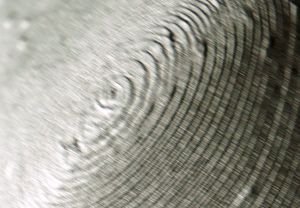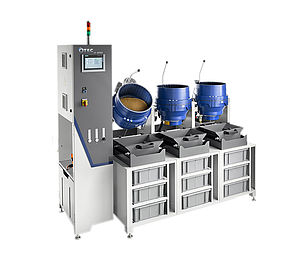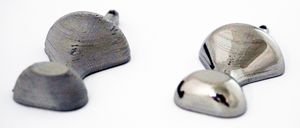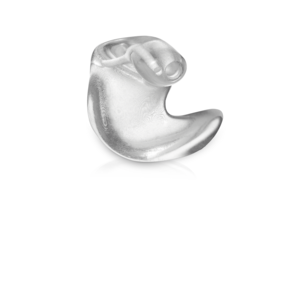OBTAIN THE PERFECT FINISH ON ADDITIVELY MANUFACTURED WORK-PIECES, WITH DISC FINISHING!
According to DIN 8580, 3D printing is one of the primary forming manufacturing processes, in which a solid body with a geometrically defined shape is produced from a formless material. The process employs a wide range of materials such as metals, plastics and ceramics. Discovered over 30 years ago, additive manufacturing processes are now sufficiently mature as to be gaining a gradual foot-hold in industrial production. Whether for prototypes or series production, additive manufacturing is used across all industries for visible and functional components as well as customised design products. Jewellery parts, dental implants, earmoulds and engine blades are just a few examples.
And the greater the possibilities of this generative process, the higher the workpiece specifications become. Series quality is the name of the game, which means that surface quality, repeatability and process reliability are under the post-processing spotlight.
Additively manufactured parts present a specific post-processing challenge

All 3D printing processes selectively apply the layers of a component, i.e., it’s composed of succes-sive layers. This principle makes component forming both flexible and customised. Being layered, 3D printed parts have a distinctive surface structure characterised by striations, pores, fissures and cavities.
Three classic solutions for improving surface quality and reducing the staircase effect
The conventional solutions are manual post-processing, solvent vaporising or mass finishing, for example vibratory tumbling.
The downside of the first option is that the human factor in manual smoothing and polishing is not cost-effective in terms of repeatability and process times.
Chemical smoothing processes require time-consuming and therefore costly work to prepare, replace and dispose of solvents. The acquisition costs are also higher than for other post-processing techniques, which essentially defeats the object of efficient volume production.
Vibratory finishing, on the other hand, involves no chemicals. But process times can be very long and hence often uneconomical.
So is there an alternative? Can you obtain series quality on 3D printed parts made from a range of materials? You certainly can!
OTEC disc finishing machines produce homogenous surfaces very quickly, without chemicals
OTEC disc finishing machines homogenise spongy, porous surfaces much faster by smoothing and polishing them.
This comes down to our machines’ mechanical operating principle: workpieces up to fist size (depending on machine configuration) are placed in the blue process container as bulk or piece goods along with grinding and polishing media suitable for the workpiece geometry.
The container floor is a disc with a rotary bearing. When the disc turns at the bottom of the fixed container, the contents are set in motion in a toroidal flow. Centrifuging the workpieces and abrasive makes this a highly intensive and purely mechanical process.
Often imitated, never matched: the OTEC CF Series is renowned for application flexibility, repeatability and process reliability

Flexible workflow: workpieces and abrasive can easily be changed in each container. The machine is modular, so you can run different post-processing steps in different containers in parallel, regardless of whether the workpieces are the same.
Consistent parameters guaranteed time after time: the machine’s central control unit lets you store and monitor workpiece-specific process parameters that you can run at the press of a button.
Time is money!
- Compared with vibratory finishing, OTEC disc finishing machines have a much higher mechanical abrasion level. For manufacturers of 3D printed parts, that means shorter process times – by a factor of 5 to 10.
- And unlike chemical smoothing, our CF machines use no harsh chemicals such as solvents. They are safe to handle, simplify the workflow and save you time. What’s more, they’re cheaper to buy and operate. In short, they cut series production unit costs.
- Our machines reduce manual rework to the absolute minimum if not to zero. That largely depends on the application in question and on your finishing requirements. Generally speaking, repeatable, reliable mechanical processing with disc finishing cuts the cost of manual work by 80%. Only the final polish – for example with jewellery – needs to be done by hand
CF processing example: SLS manufactured metal workpieces

In finishing tests with metal workpieces printed using SLS, the OTEC disc finishing machine achieved an average of 1–2 hours per batch..
CF processing example: 3D printed plastic earmoulds

Depending on the number of parts and their initial state, you can vary abrasives and runtimes. The average time for each step in the process is 1–2 hours. And depending on the machine you can also process larger batches simultaneously. From small runs to vol-ume production, the The OTEC CF Series is the perfect choice.
WORKPIECE-ABRASIVE SEPARATION: THE UNISEPA MOBILE SCREENING UNIT – COMPACT AND FLEXIBLE
THE UNISEPA MOBILE SCREENING UNIT – COMPACT AND FLEXIBLE
The new OTEC Unisepa is a universal solution for separating grinding bodies from a variety of work-pieces. With settings options for the flow regulator, vibration frequency and vibration amplitude, the UNISEPA can handle just about any separation task.
Video of CF 1x18 with Unisepa:
Video CF 1x18 with Unisepa (Youtube)
Every workpiece is different: put us to the test!
Send us your samples and let our experts at the OTEC Finishing Center specify your custom process.




